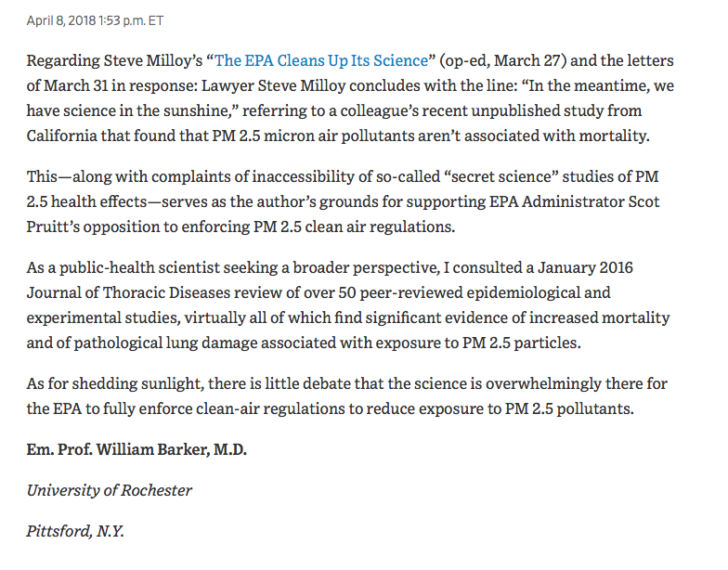My March 27 Wall Street Journal op-ed “The EPA Cleans Up Its Science” was attacked in a letter-to-the-editor by University of Rochester emeritus professor William H. Barker. I report you decide — and don’t let the title of this article do it for you.

Barker’s letter is below. He has no idea of what he writes.

My bottom-line view, explained in detail in “Scare Pollution: Why and How to Fix the EPA” is simply that if the studies EPA has relied on are so unassailable, why has the agency prevented their scrutiny since 1994?
Why? Because they are fraud.
Two of my colleagues responded additionally as follows:
Colleague #1.
Prof. Barker is probably correct that “virtually all of [the studies] find significant evidence of increased mortality and of pathological lung damage associated with exposure to PM 2.5 particles.” Yet, this does not imply or suggest that PM2.5 causes the increased mortality with which it is associated, or that reducing PM2.5 would reduce mortality. These associations are created by confounders such as income and lagged cold temperatures (out to 2 weeks), together with model specification errors.
Accepting Prof. Barker’s premise that an exposure-response association is present does not imply that reducing exposure would reduce response. For example, in Dublin, where a strong exposure concentration-mortality association had been documented for black smoke and particulate matter (https://www.ncbi.nlm.nih.gov/pubmed/12401247), reducing exposure to particulate matter by perhaps 70% (about 35 micrograms per cubic meter) had no detectable effect on total (or cardiovascular) death rate even after 20 years (www.ncbi.nlm.nih.gov/pubmed/24024358). Such associations do not help to predict effects of changes in air pollution policies on public health.
It seems to me that the routine conflation of association with causation among those advocating tighter standards, as in Prof. Barker’s piece, is one of the greatest obstacles to sound and useful discussions of the effects on public health of reducing exposures.
Colleague #2.
I did a little leg work. Here is what I found.
1. The cited journal had a number of papers, 9, as a group looking at air quality and health. So far, ok.
http://jtd.amegroups.com/issue/view/165
2. The journal started in 2009 and is Chinese dominated. Virtually the entire editorial board is Chinese. The editor has excellent credentials.
3. I picked one of the articles in the set, attached. “Air particulate matter and cardiovascular disease: the epidemiological, biomedical and clinical evidence.” There are 119 citations. I know a lot of negative papers. I could not find any negative papers among the citations — like Styer 1995, Chay 2003, Enstrom 2005, Greven 2011, etc. A hit piece by the ChiComs? If so, it is well-done.
4. The journal is an “open access” journal which means the author pays for the publication. There are a number of articles, 9, in this set. All by Chinese lead authors. Who paid? Is this a vanity journal? You pay and you get your article published.